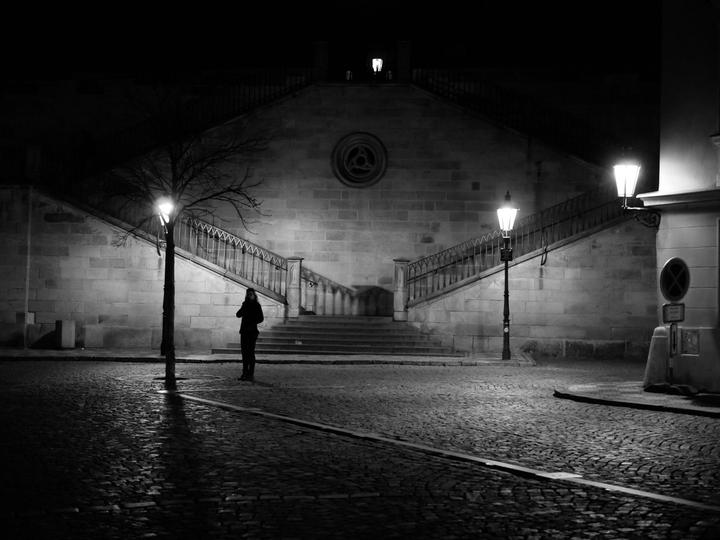Alone, Waiting in the Dark / Sama, čekající v temnotě

We were just returning from Divadlo Kampa (Kampa Theatre) — myself and my four-year-old son. It was after eight and it was dark. He held my hand. We walked slowly across the little square towards Charles Bridge.
"Pee, I need to pee," says my son.
"I just asked you a few moments ago in the theatre, if you need to go to a toilet," I reply. "Ok then, come here under this tree."
Peeing we are. In Prague, in the middle of a square. It's dark and no-one's looking. But it's freezing too so it takes a while to organise all those layers of garment of a four-year-old, that had to go down before watering the tree.
Operation successful. We keep on going. Holding a hand. The left one.
As we approach the bridge, I see a figure going down the stars. Some woman, alone. Now the strange "photographic dance" ensues. A scene manifests before ones eyes. The imagination intuitively sees a photograph. Then the stakes are, whether the scene holds till the position — composition — and readiness — promptitude and courage — of the photographer align harmony with his imagination.
With my right hand I instinctively grab the camera — habitually checking the ISO, aperture and shutter — while dragging my son little bit to the right with my other arm. The woman, which just moments ago was walking over from left to right, stopped and, so it seems, is watching us. There is not much else to watch after all.
At last, the imagination meets the circumstance. Left hand holds the child, right one raises the camera. Quick composition. Hold the breath.
Click, click.
Done. My son did not even notice. Did she?
It was just a few seconds and down the stars came another figure. The one she was waiting for. With his arrival the magic of the moment leaves — the notion of tension, mystery and lone expectation.
First moral: The basic rule of photography (and Boy Scouts) reads always ready. That means having a camera not just "with me", but having it at hand, ready to be used. The scene like this just cannot be taken, if you need to pull the camera out of a bag — and often even out of a pocket.
Second moral: Some photographers believe it is possible to "force luck" — to raise ones chance of manifestation of interesting moments. It cannot be proven, but I thing there is something to that. At least in my case there is a big difference whether I walk out with my camera in the bag or whether I have it ready on my neck, or even i my hand. In the second case the chance is much higher that I even notice something worth my photographic attention.
It can be explained both by a change of a mental state and also more poetically — by the possibility of actively accelerating ones luck. Be it as it may, one thing is for sure: were we not peeing, this photo would not exist.
Právě jsme šli z Divadla Kampa — já a můj čtyřletý synek. Bylo po osmé a byla už tma. Držel se mně za ruku. Pomalu jsme procházeli přes náměstíčko námestíčkem ke Karlovu mostu.
"Čůrat, potřebuju čůrat," říká syn.
"Vždyť jsem se tě před chvílí v divadle ptal, jestli chceš na záchod," říkám na to. "No, tak pojď tady ke stromu."
Čůráme. V Praze, uprostřed náměstí. Ale je tma a nikde nikdo. Ale také mrzne, a tak chvíli trvá, než čtyřletému dítěti srovnáte všechny ty vrstvy oblečení, které musely před močením dolů.
Povedlo se. Pokračujeme dál. Za ruku. Levou.
Jak se blížíme k mostu, vidím, jak po schodech z mostu schází postava. Nějaká žena, je sama. Nyní začíná onen zvláštní, "fotografický" tanec. Před očima se zhmotní scéna. Představa v ní intuitivně vidí fotografii. Následně se pak hraje o to, jestli scéna vydrží, než se pozice — kompozice — a připravenost — pohotovost a odvaha — fotografa v harmonii potkají s onou představou.
Instinktivně beru do pravé ruky fotoparát — a dle zvyku rychle zkontroluji ISO clonu a čas — a druhou rukou táhnu synka kousek doprava. Žena, která ještě před chvílí popocházela sem a tam, se zastavila a, zdá se, hledí na nás. Koneckonců nic jiného kolem k hledění není.
Konečně se představa potkala se situací. Levá ruka drží dítě, pravá zvedá fotoaparát. Rychle nakomponovat. Zadržet dech.
Cvak, cvak.
Hotovo. Synek si ani nevšiml, že jsem něco fotil. Všmla si ona?
Pár vteřin poté začala po schodech přicházet další postava. Ten, na koho žena čekala, právě dorazil. S jeho příchodem přešlo i kouzlo okamžiku — obraz napětí, tajmena a osamnělého čekání.
První poučení: Základní pravidlo pouliční fotografie (a Pionýrů ;-)) je být vždy připraven. To znamená mít foťák nejen s sebou, ale mít ho stále k dispozici, po ruce, připravený k použití. Scénu jako je tahle prostě nelze zachytit, pokud je nejprve třeba vytáhnout fotoaparát z batohu — a často i jen z kapsy.
Druhé poučení: Někteří fotografové jsou přesvědčení, že je možné aktivně "pracovat na štěstí" — zvýšit šanci manifestace zajímavých momentů. Nedá se to dokázat, ale mám pocit, že na tom něco je. Alespoň v mém případě je veliký rozdíl, jestli jdu ven s tím, že mám foťák s sebou v batohu a že ho mám připravený na krku, případně dokonce v ruce. V tom druhém případě je mnohem větši šance, že si vůbec všimnu něčeho, co stojí za mou fotografickou pozornost.
Je možné si to vysvětlovat jak změnou mentálního rozpoložení, tak i poetičtěji — že je možné vlastním aktivním krokem uspíšit štěstěnu. Ať tak nebo tak, jedno je jisté: kdybychom nečůrali, tahle fotka by neexistovala.
— snílek
(Praha – Kampa, 24.2.2018)
Comments
Comments powered by Disqus